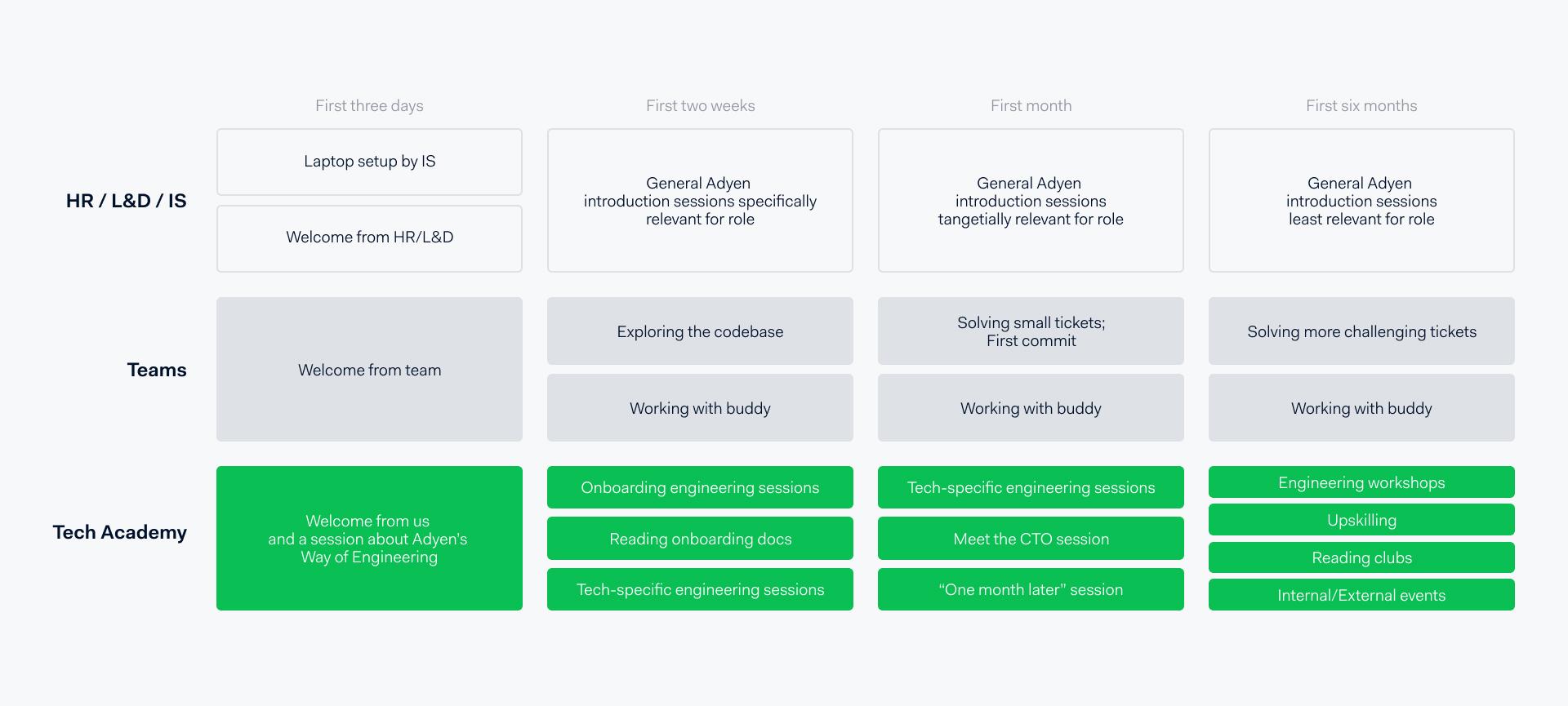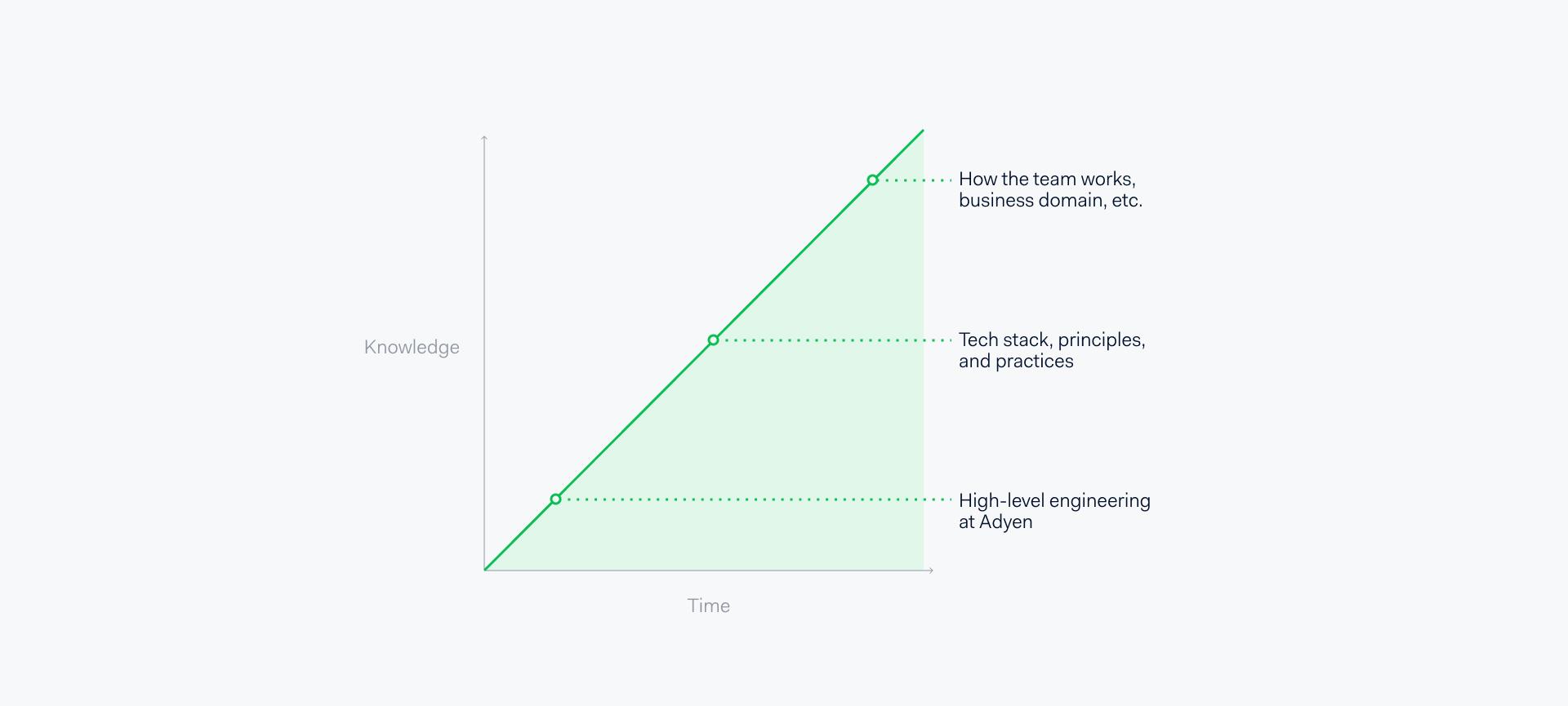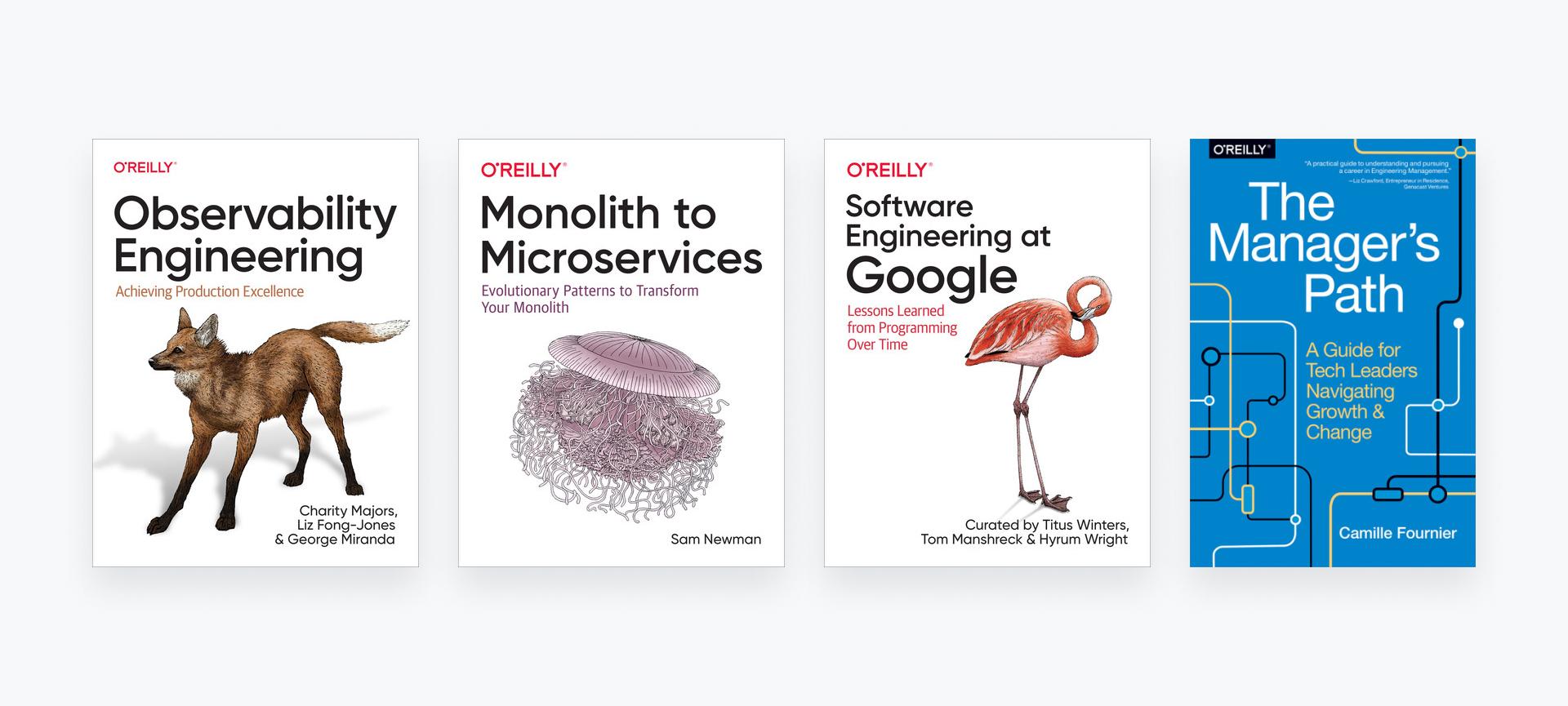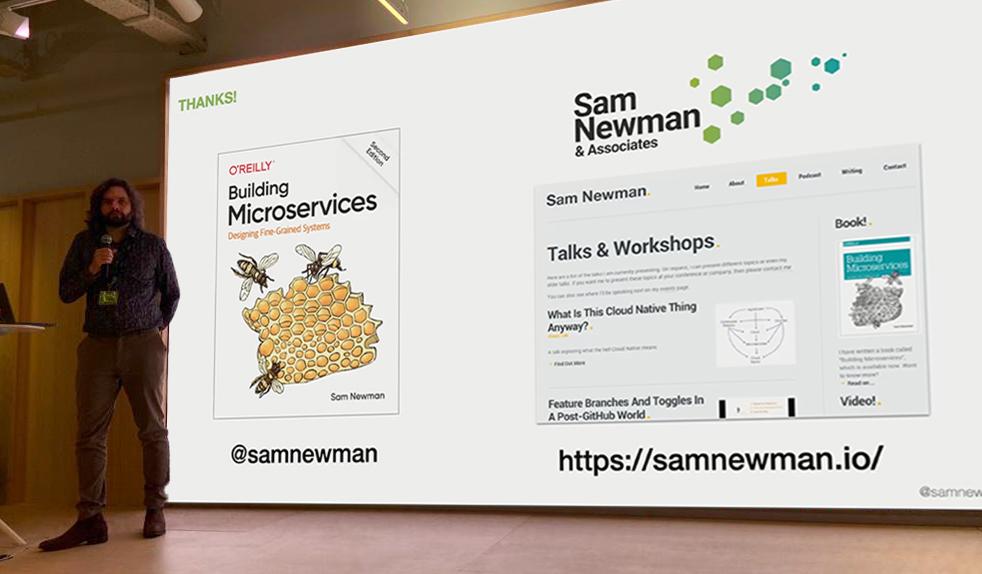Guides and reports
Adyen Tech Academy: Taking Onboarding and Upskilling to The Next Level
by Maurício Aniche, Alexander Tiplea, Carianne Pretorius and Erik de Gooijer

Helping engineers get up to speed quickly and get even better at their jobs is a must for any tech company. It’s also an enormous challenge.Fortunately, we at the Adyen Tech Academy are here and ready to help our engineers on their learning journey!
We're currently celebrating our first year of existence in the company and we have learned a lot during this time. In the next sections, we'll convince you why having a tech academy is important, explain how we handle onboarding and upskilling, and outline some of the challenges we have faced when building our academy.
Why do we need a Tech Academy?
Any company that wants to scale up needs to think about how they will onboard (many) new engineers, effectively, within short periods of time. Throwing new joiners into teams and hoping they will catch up is rarely productive. Moreover, proactively supporting engineers in becoming a better version of themselves is imperative for their growth. This is not only beneficial for engineers, but for employers as well. Engineers update their skills and increase their market value, and Adyen benefits from having stronger engineers who are better equipped to tackle our ever-growing technical challenges.
With this in mind, the Tech Academy was born, our broad objective being to support engineers during their onboarding process and thereafter. We have boldly set our mission to be:
- Making the onboarding of the new engineers an enjoyable and effective experience.
- Enabling engineers to develop their technical skills within Adyen.
- Fostering a learning culture where engineers feel safe to learn and share.
In stark contrast with academies that are typically organized by Learning and Development (L&D) departments, Adyen Tech Academy emerged from within the engineering department itself. In practice, this means that we’re a new team under the engineering umbrella, and fall directly below our CTO. This embodies our view that "we are tech for tech," and we strongly believe that much of our current success can be attributed to our ability to work closely with our own engineers who understand the challenges of onboarding and upskilling.
Onboarding: getting engineers up to speed
Onboarding is the first adventure that all new engineers embark on. Research shows that a great onboarding experience canalmost double your chances of retaining new employees, and even increase their productivity by 70% during the first year. Equipped with fuzzy directions and some kind of map (if they’re lucky), new joiners must wander about the company to their final destination. But what is this destination, exactly? And how can we best equip our engineers to make it there? These are the two major questions that we try to address.
We really want our engineers at Adyen to have a cohesive, stimulating, and fun experience in their first weeks. At the same time, we aim to equip them with tools and resources to confidently face any challenges that might arise in their new role.
We view our engineering onboarding at Adyen as a process that spans approximately six months, though in practice it can vary per role and per specific engineer. There are three primary groups that facilitate this process: (1) The HR and L&D departments who provide new joiners with a glimpse of what Adyen is, (2) the team that the engineer is joining together with their assigned buddy and (3) us at the Tech Academy focusing on the tech side of things. We outline the process broadly below.

Overview of our engineering onboarding process.
First three days
The first three days at Adyen are super busy for all new joiners, but even more so for engineers. On day one, new joiners spend their morning being introduced to the company by HR and meeting each other as fellow colleagues. After a nice social lunch, they spend most of the afternoon setting up their laptops. There's so much to configure, including access to email, internal communication, access to code repositories, and security-related software. Our amazing Business Infrastructure team has recorded a step-by-step video tutorial which new joiners follow. If any question emerges, they will be available to help. In the remainder of the day, the new joiners are welcomed by the HR and L&D teams. They talk mostly about how life at Adyen is and where to go in case of any HR-related questions. The new joiners end their first day with meeting their teams. The second day is a similar format.
On day three, it is time for engineering new joiners to get to know the Tech Academy. We also give them a warm welcome to the company and explain what their technical onboarding will look like. Although tech is the focus of our onboarding, the major part of this first session is focused on the interpersonal and organizational side of things. We make sure they understand that joining a new company is always challenging and that here at Adyen, they will have enough time and space to get up to speed. We also make sure that they get to know each other a bit better through small conversation circles. After all, it's always nice to meet someone facing the same new challenges as you.
First two weeks
The next two weeks for engineering new joiners involve a mixture of technical presentations from the Tech Academy, rolling up their sleeves and exploring the codebase, conversations with team members, and company-wide presentations from HR.
We tell new joiners that their main focus should be working together with their buddy. We always assign someone from the new joiner’s team to be their buddy. The responsibilities of the buddy encompass supporting the person in getting up to speed. They explain what their team does in detail, point the new joiner to the right setup guides and documentation, walk them through the code base, work on some first tasks with the new joiner, and help them increase their network within the team and the company.
At this point, new joiners also start taking our training sessions. In the first two weeks, our focus is more high-level; there is no need to overwhelm new joiners with information they don't yet need or have the ability to fully grasp at that moment. After all, they are just starting. Instead, we give talks about our engineering principles, how our release processes work, our databases, social etiquette when doing code reviews, and how to use our build tools. These presentations are role-specific. A data scientist will not learn about how we scale our financial platform, but will learn about how we scale our data platform. These presentations are often given by (senior) engineers in the company; this also allows new joiners to meet "go-to people" in case they have questions about specific topics.
Depending on their team, new joiners may benefit from specific HR presentations more than others. For example, if an engineer joins a team that does In-Person Payments (IPP) development, they may benefit from hearing the business presentation about IPP more than someone that joins, say, our banking teams. We give new joiners a list of presentations that they should follow right at the start, as well as which ones they only need to follow later on.
First month
After the first two weeks have passed, the new joiner has more clarity on how Adyen works and what they should focus on in terms of learning. Suppose an engineer is in a team that heavily uses technology X. Even if a new joiner already knows technology X from previous experience, they still need to learn how Adyen uses it, our best practices, and lessons learned. For that, the new joiner can subscribe to one of the many sessions about elements of our tech stack that the Tech Academy offers. We currently offer more than 20 different courses covering our tech stack.
Something that sets us apart from companies that "require" new joiners to follow courses and even assign them from day one, is that we take the approach of suggesting that the new joiners are the ones responsible for enrolling themselves. Why do we do this? Because there's no-one better than the new joiner (along with their buddy) to decide when it's time to learn about a specific technology. If the person isn't going to use a technology for the next six months, why learn about it at this moment when there is already so much to learn that impacts their daily work now?
We also make sure to synchronize with new joiners regularly to see how they are going. In particular, at the end of the first month, we host a gathering where we openly discuss how they are doing, as well as things that they liked and disliked in the onboarding process, so that we can keep improving. Around their fourth week, new joiners also have the chance to meet our CTOAlexander Matthey. In this session, new joiners can ask him any questions they want on the spot. Questions vary from "why did we choose this tech?" to "what's our next big impactful solution?" or "what does a CTO do?". Having the opportunity to chat informally with the CTO inspires new joiners to see that they are already valued as colleagues, and emphasizes the reality that they are capable of making an impact at Adyen no matter how new they are to the company.
First six months
Around six months, we expect the new joiner to be confident as an engineer, and know their way around the company and our tech stack. It is time to start working on becoming an even better engineer. Or to upskill, as we call it.
All-in-all, the onboarding goes from high-level presentations on how engineering works at Adyen, up to how our tech stack works, up to how the specific team works. New joiners start from the more generic to the more specific, as you see in the figure below.

The type of knowledge we share and when.
We believe that the new joiner is strongly responsible for their own onboarding. That is why we let the new joiners decide when it's time to take courses (differently from other companies who force a strict schedule!), join some upskilling activity, or when it's time to ask for help.
Upskilling: making engineers better
Improving as an engineer is also a must, not only for the engineers themselves as they keep improving their market value, but also for companies as their challenges keep growing. At Adyen Tech Academy, we do our best to keep offering activities for engineers to further their own learning. In particular, we offer workshops, organize reading clubs, and promote talks from internal and external experts.
Workshops
We offer workshops on topics that our engineers are often curious and like to talk about, such as testing, architecture, and software design. We organize these workshops not as "lectures", where one person speaks for 90% of the time. Rather, these workshops are designed to ensure participants are active, share their experiences from their teams, and discuss how we can have an even bigger impact at Adyen as engineers. This means that every offering is essentially unique, inspired by the participants.
The moderator of the workshop is mostly responsible for guiding the discussion. We also make sure to pick a moderator that deeply understands the topic, so if there's any misunderstanding about a principle or a technique, the moderator can help facilitate a common understanding.
Reading clubs
There are so many interesting books worth reading in the tech space, but so little time. To keep reading and learning, it really helps to be accountable to a friend who is reading along and discussing with you. With this in mind, we organize different reading clubs about books our engineers are curious about. These reading clubs usually take four to six weeks, where each week focuses on one or more pre-selected chapters of the book. Monoliths to Microservices, Observability Engineering, and Software Engineering at Google are just a few examples of the books we collectively read. We have also started experimenting with reading clubs focusing on the interpersonal and organizational side of software engineering either directly or indirectly, such as HBR Guide to Women at Work.
We have no prescriptive format to run these reading clubs and they vary a lot, usually according to the wishes of the participants. In some reading clubs, we nominate a person to be responsible for making a short presentation about the chapter(s) for the session. In others, it's a free format and people just talk about what they think about the chapter(s), for example, what they like and dislike, or agree and disagree with.

Some of the books we collectively read this year.
Talks
There's so much knowledge inside our company, and we do our best to make sure this knowledge gets out of its bubble for others to learn from. Whenever an engineer has an interesting topic, we help the person to create a presentation and deliver it to our engineers. What engineers usually need to get it done is just a little bit of support and encouragement, so our approach is to just walk with them through this journey. When the person is less experienced in creating and giving talks, we give them more comprehensive tips on how to present.
There's also a whole bunch of knowledge that exists outside the company, and hearing different ideas always helps us to sharpen our perspectives. To that end, we do our best to invite world-class engineers to give talks at Adyen.Sam Newman(the author of Monoliths to Microservices),Steve Freeman(Growing Object-Oriented Systems Guided by Tests),Yehonathan Sharvit(Data-Oriented Programming), andGergely Orosz(The Pragmatic Engineer) are a few of the names we had this year. We also have invited academics to talk about their research.Michael Hilton(who spoke about mob programming),Jonathan Bell(flaky tests) andBurcu Kulahcioglu Ozkan(testing distributed systems) are among the speakers.

Sam Newman, the author of Building Microservices, giving a talk to 100+ engineers at Adyen in our auditorium.
In our approach we keep our activities as engaging as possible, with a strong emphasis on live and in-person meetings. We feel that this contributes to an environment where knowledge is easily shared and true connections between engineers are built. Of course, engineers working from home are always welcome to join any session!
Challenges in building a Tech Academy
We are proud of what we have built in this first year! We still have many challenges ahead of us. Here, we outline three of them: build team-specific onboarding experiences, keep people engaged, and find better ways to measure the impact of our activities.
- Team-specific onboarding. Although we can build courses that are relevant for all engineers, a lot of the challenges related to onboarding are very specific to the team that the person is joining. We have many teams at Adyen, and building a tailor-made onboarding experience for each of them is costly.
- Consistent engagement. Keeping engineers excited about learning requires a continuous investment. Otherwise, it's just too easy for them to "focus on their work", especially engineers that have been at the company for a long time.
- Scaling to our other dev hubs. Adyen has multiple development hubs all over the world, including Chicago, Brazil, Madrid, and Singapore. This means that we need to scale our offerings as these hubs emerge and grow.
- Better measuring our impact. This blog post describes our current learning strategies, but we are always experimenting with different things every onboarding session. However, precisely measuring the impact that our onboarding process has on, say, how long it takes for someone to be fully productive in their time, is tough.
This is just the beginning!
Having effective onboarding procedures in place, and successfully supporting engineers in their upskilling are first-class citizens for any tech-first company, and especially the ones that want to grow fast! Our Tech Academy exists for this reason, and we are absolutely committed to helping our engineers onboard and grow.
We learned a lot during our first year! Based on the numbers from our activity and offering back office application (that we built ourselves), here is a sneak peek of how far we’ve come:
- We developed and offered 81 distinct activities.
- These activities, all together, were offered 237 times.
- We had a total of 4,068 engineers taking part of all these activities.
- 763 unique engineers joined at least one of the activities, a significant part of our engineering population.
- 62 different trainers facilitating all these activities.
- 138,000 minutes of video or pages collectively read in O'Reilly.
… all in the span of around six months (as our back office went live on 3 May 2022).
Nevertheless, while we have made great improvements in the process, we still have a long way to go. Do not fret if you are yearning to know more alongside us, we'll keep sharing our learnings with you.
Fresh insights, straight to your inbox
By submitting your information you confirm that you have read Adyen's Privacy Policy and agree to the use of your data in all Adyen communications.